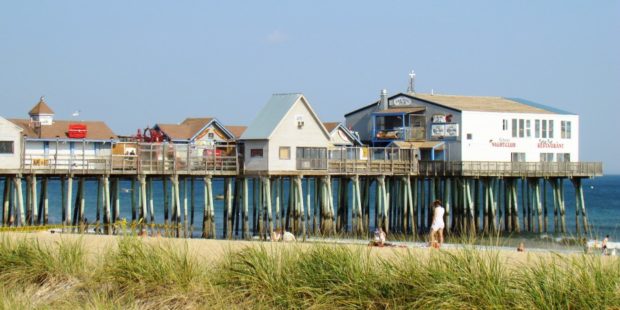
| Year | Population |
|---|---|
| 1970 | 5,404 |
| 1980 | 6,291 |
| 1990 | 7,789 |
| 2000 | 8,856 |
| 2010 | 8,624 |
| Geographic Data | |
|---|---|
| N. Latitude | 43:31:37 |
| W. Longitude | 70:23:40 |
| Maine House | District 13 |
| Maine Senate | District 31 |
| Congress | District 1 |
| Area sq. mi. | (total) 7.6 |
| Area sq. mi. | (land) 7.5 |
| Population/sqmi | (land) 1,150 |
|
County: York Total=land+water; Land=land only |
|
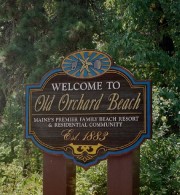 [OR-chd] is a town in York County incorporated on February 20, 1883 as Old Orchard from a portion of the town of Saco. Named for an orchard set out by Thomas Rogers in 1638, it added the word “Beach” to its name in 1929.
[OR-chd] is a town in York County incorporated on February 20, 1883 as Old Orchard from a portion of the town of Saco. Named for an orchard set out by Thomas Rogers in 1638, it added the word “Beach” to its name in 1929.
Richard Boynthon settled the area in 1631 and hosted meetings of the councilors governing Sir Fernando Gorges‘ Province of Maine in the early 17th Century. Thomas Roger planted an apple orchard in 1638 that became known as “Rogers’ Garden by the Sea” by 1657.
The “old orchard” was on high land behind the beach and became a landmark for sailors.
Seeds of tourism might be traced to the first “public house,” an inn serving coach travelers in 1820. In 1837, E. C. Staples began taking in boarders at his farm. He later established the Old Orchard Boarding House.
The Boston to Portland railroad passed within two miles of town in 1842 and the Grand Trunk Railroad connected Old Orchard Beach to Montreal in 1853, encouraging Canadians to visit the beach. By 1873 the Boston & Maine Railroad passed through the town, now served by Amtrak.
As tourism-based building accelerated, the electric trolley linked Biddeford to the beach in 1892; another connected Portland in 1903.
The “great fire” of 1907 destroyed most of the beachfront properties, which were soon rebuilt.
In June of 1927, Charles A. Lindbergh landed his plane, the Spirit of St. Louis, on Old Orchard Beach on his tour of the United States following his historic solo New York to Paris flight. He had attempted landing in Portland, but fog obscured the airport.
The town, with its long beach, carnival atmosphere, and famous Pier on which the big bands such as Duke Ellington and Guy Lombardo, as well as Rudy Valle played, has been a recreational playground for over a century.
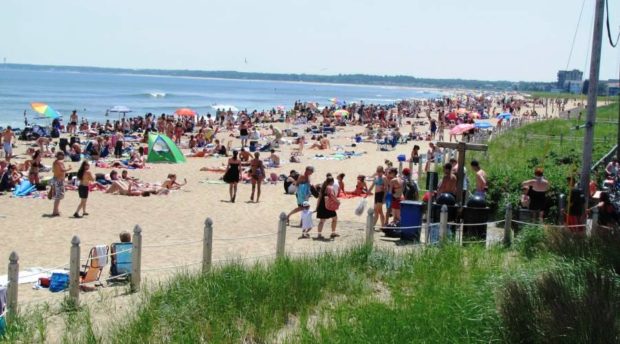
Located on Saco Bay just east of the The Pier, the Beach draws hundreds of thousands of tourists each summer, including many Canadians.
Heavy storms severely damaged and partially destroyed the pier in 1909 and in 1978. The current pier was opened in 1980. Though small in area, the town is one of the most densely populated areas of the state.
Saint Margaret Church Bell Tower
Old Orchard Beach had one of the recommended “travel homes” in the post World War II guide “The Negro Travelers’ Green Book.” It was the Mrs. R. Cumming’s Tourist Home. 110 Portland Avenue, that served African Americans when many others did not.
Form of Government: Council-Manager
Additional resources
Bachelder, Peter Dow. The Great Steel Pier: An Illustrated History of the Old Orchard Ocean Pier. Ellsworth, Me. The Breakwater Press. c1998.
Blaney, Daniel E. Old Orchard Beach. Charleston, SC. Arcadia Publishing. c2007.
Cole, Alton Bryant. A Biography of a Railroad : the Dummy Line of Old Orchard Beach. Thesis (M.A.) in History–University of Maine.1969.
Cournoyer, Jill C. Victorian Retreat to Amusement Capital: the transformation of Old Orchard Beach, Maine at the Turn of the Century. 1996.
Maine. Historic Preservation Commission. Augusta, Me. Text and photos from National Register of Historic Places.
Jakeman, Adelbert M. Centennial History of Ocean Park, Maine, 1881-1981. Ocean Park, Me. Ocean Park Association. 1981.
Old Orchard Beach and Vicinity. Portland, Me. L. H. Nelson Co. 1906. [Maine State Library]
Old Orchard Beach Historical Society.
Old Orchard House, Old Orchard Beach, Maine. Publisher Portland, Me. Lakeside Press.
Locke, John Staples. Historical Sketches of Old Orchard and the Shores of Saco Bay: Biddeford Pool, Old Orchard Beach, Pine Point, Prout’s Neck. Boston. C. H. Woodman. 1884.
Locke, John Staples. Shores of Saco Bay; A Historical Guide to Biddeford Pool, Old Orchard Beach, Pine Point, Prout’s Neck. Boston. c1880.
Scully, Jeffrey A. The Old Orchard. Dover, N.H. Arcadia Publishing. c1995.
Warner, Raymond. “The Crescent-enthroned Queen of the Maine Coast.” New England Magazine. 1909. [Maine State Library]
National Register of Historic Places – Listings
Cummings Guest House
[110 Portland Avenue] The Cummings Guest House is a type of lodging that catered to African American tourists in the years before they were guaranteed equal access to eating and sleeping accommodations by law. Its significance is enhanced by the renown of some of its famous African American guests, who stayed at the Guest House while performing in Old Orchard Beach. In 1917 Rosvell (Rose) Shurtleff Emerson Cummings and Charles Edward Cummings Jr. moved from Massachusetts to Old Orchard Beach.
They bought a small farmhouse at 110 Portland Street (now Portland Avenue) and became the town’s only black residents. The family had five daughters and two sons, whom Charles supported in part by working as a porter at Union Station in Portland. The family kept a few animals in the barn on their suburban lot, just a few blocks from the beach its thriving waterfront. Between 1917 and 1924 the Cummings family appears to have lived in the tourist community year round. In later years they sometimes spent only summers in Old Orchard Beach, and lived either in Portland or Winchester, Massachusetts in winters. In 1923 the family remodeled their farmhouse and opened their doors to African American travelers, an enterprise that was to bring them business for the next 70 years.
Old Orchard Beach was one of a string of seaside resorts in Maine that became popular at the end of the 19th century. It became increasingly accessibly via rail and then automobile in the early 20th century. Along with the requisite grand hotels, sandy beaches, eateries and amusements, Old Orchard Beach became known for it extensive pier and boardwalk, which at one point stretched 1800 feet into the water and featured its own miniature passenger rail line along its length. Although the pier was rebuilt many times due to storm damage, one of its biggest attractions was the Casino, a popular nightclub, that featured all of the Jazz and Swing greats of the era. From the late 1800s to the present, Old Orchard Beach has drawn travelers from throughout the East Coast and Canada, and in the 1920s and 1930s its scale was almost unrivaled.* [Christi Mitchell photos]
Ocean Park Historic Buildings
[Temple Avenue Ocean Park] “Temple Square”, the area where these three buildings and the bell tower stand is the focal point of Ocean Park. The Park is a family style summer community with a religious background. Dedicated to self improvement, very few of these denominational reservations, so prevalent in the 19th and early 20th centuries, still exist. Among them Ocean Park is perhaps the least changed from its original plan and purpose. (See “The Temple” below).
When Ocean Park was built in 1881, approximately 24 lots were set aside and known as Temple Square. No tenting was allowed in this area, which was to hold the Assembly Buildings. The first building, a unique octagonal wooden structure, The Temple, was built and dedicated in 1881. This was followed in 1882 by a Bell Tower used to call people to assembly programs.
This was the era of permanent “Chautauquas,” founded after the mother institution in Chautauqua, New York with which Ocean Park had associations for many years. In those days it was felt that there were three physical requirements for an assembly site: water (lake, river, or ocean), a grove of trees, and a bell tower. From the early beginnings other space was needed for meetings besides the Temple and various tents served these functions. In 1902 a permanent building, Porter Hall, was built to replace “The Tabernacle,” one of the tents. Of Classical Revival design, it has functioned for over 75 years, and was the Ocean Park home of the (Chautauqua Literary and Scientific Circle) for about 50 of those years. In 1915 another permanent wooden building, Jordan Hall, was added to the site. It has ionic columns and a wooden beam ceiling. All four structures have been essentially unchanged over the years. They all share the same grove of Cathedral pines whose history far precedes them.* [Frank A. Beard photos]
Staples Inn
[8 Portland Avenue] The coming of summer resorts along the Maine coast in the 19th century radically changed development patterns in the state. Old Orchard Beach is among the earliest of these resorts, and the Staples Inn is the oldest known place in Maine to have taken in summer boarders on a regular basis. It is the only surviving hostelry that is associated with the life of Ebenezer C. Staples (1808-1895), Old Orchard’s pioneer resort hotel keeper.
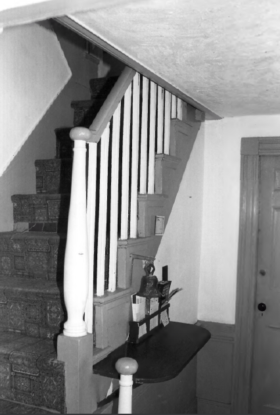 Possibly built during the third quarter of the 18th century, the building that became known as Staples Inn was acquired by Elisha Staples in the 1790’s. His grandson Ebenezer C. Staples first opened the farmhouse in 1840 to “foreign visitors,” many of whom were Canadians from the Montreal area. With the completion in 1842 of the Portsmouth and Portland Railroad and in 1852 the Grand Trunk Railroad from Montreal, tourists could easily be delivered to the Saco station within four miles of the beach. The increased tourist trade made it possible for Staples to enlarge the ancestral farmhouse until, by the mid 1870’s, he could accommodate 300 guests at his Old Orchard House.
Possibly built during the third quarter of the 18th century, the building that became known as Staples Inn was acquired by Elisha Staples in the 1790’s. His grandson Ebenezer C. Staples first opened the farmhouse in 1840 to “foreign visitors,” many of whom were Canadians from the Montreal area. With the completion in 1842 of the Portsmouth and Portland Railroad and in 1852 the Grand Trunk Railroad from Montreal, tourists could easily be delivered to the Saco station within four miles of the beach. The increased tourist trade made it possible for Staples to enlarge the ancestral farmhouse until, by the mid 1870’s, he could accommodate 300 guests at his Old Orchard House.
On July 21, 1875, the Old Orchard House was, with the remarkable exception of the original 18th century building, completely destroyed by fire. Undaunted, Staples immediately built a new and much larger hotel, which he also named the Old Orchard House. This building, capable of housing 600 people, survived the disastrous fire of 1907 which destroyed much of Old Orchard, but it was later torn down.
 The immediate post-fire history of the 18th century farmhouse is not known. By 1881, however, it had been remodeled and given the name Staples Cottage under the direction of Mrs. M.F. Libby. During this period the present recessed two-story wing was built. The Staples Cottage continued to operate under this name until the early 1920s when a new proprietor changed its designation to the Staples Inn. Unlike the summer resorts for wealthier visitors such as Bar Harbor, Old Orchard was always frequented predominantly by middle class vacationers. Consequently, the area has continually undergone rapid development. In this area, few unaltered 19th century structures survive. That the Staples Inn remains standing with much of its original 18th century interior woodwork is quite extraordinary.* [Frank A. Beard photos]
The immediate post-fire history of the 18th century farmhouse is not known. By 1881, however, it had been remodeled and given the name Staples Cottage under the direction of Mrs. M.F. Libby. During this period the present recessed two-story wing was built. The Staples Cottage continued to operate under this name until the early 1920s when a new proprietor changed its designation to the Staples Inn. Unlike the summer resorts for wealthier visitors such as Bar Harbor, Old Orchard was always frequented predominantly by middle class vacationers. Consequently, the area has continually undergone rapid development. In this area, few unaltered 19th century structures survive. That the Staples Inn remains standing with much of its original 18th century interior woodwork is quite extraordinary.* [Frank A. Beard photos]
Temple, The
[Temple Avenue in Ocean Park] What came to be called “The Temple” was designed by the firm of Dow and Wheeler, built in 1881 by James Bickford of Portland. It is one of two religious structures in Maine designed in the octagon form. The other was a church, now a library, in Andover.
It is the focal point in Ocean Park and has thrived over the years with a variety of programs. The Temple has provided entertainment including first run motion pictures. Sunday services have been conducted by eminent theologians and preachers of many denominations. The Temple represents an unusual, once popular, architectural form. It also symbolizes an ongoing commitment to an admirable nineteenth century ideal. [Frank A. Beard photo]


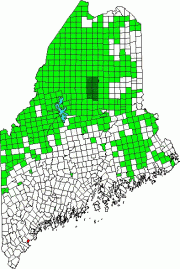

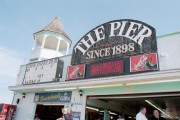
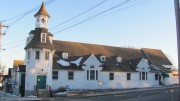
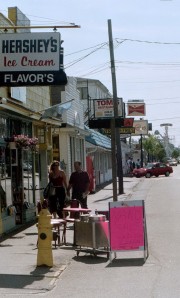
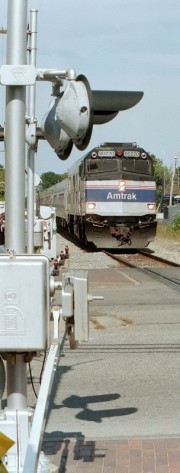
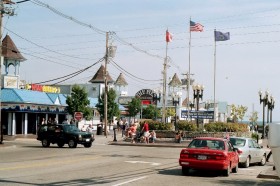
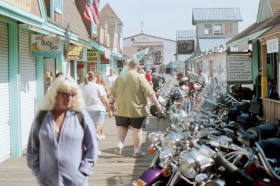

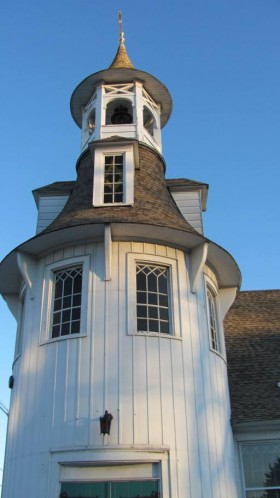

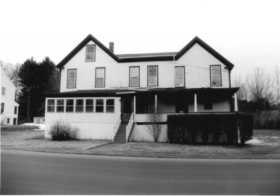
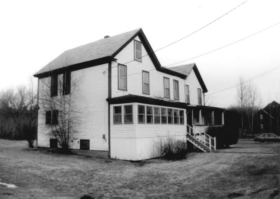
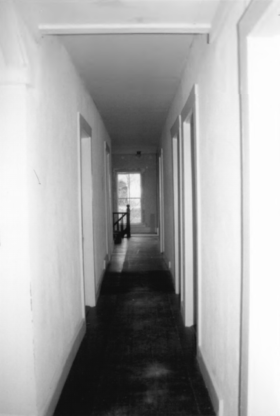
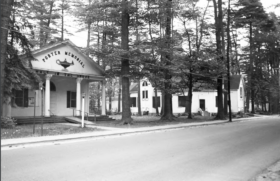
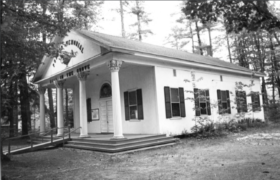
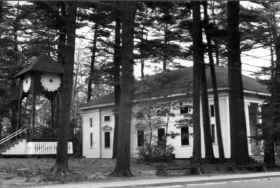
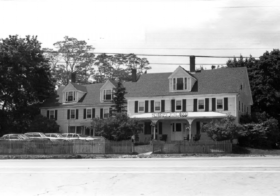
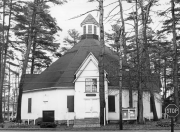
Do you [does anyone] have any information of a boarding house named The Argyle House in Old Orchard? At least that is what I believe it was called. My father’s uncle and aunt use to run it back in the 1960s. My memory is fading so I can’t give you much else to go by.
thanks